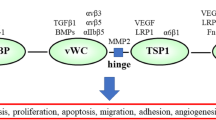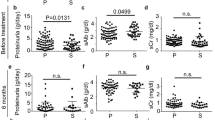Abstract
Diffuse mesangial sclerosis, isolated (IDMS) or observed in the context of Denys-Drash syndrome (DDS) due to WT1 mutation, is characterized by early onset nephrotic syndrome progressing to renal failure. A striking morphological feature is the rapid development of glomerulosclerosis. The aims of our study were: (1) to analyze the glomerular distribution of extracellular matrix (ECM) antigens at the early stage of DMS, (2) to determine the composition of the ECM accumulated within the mesangial areas and leading to glomerular sclerosis, and (3) to analyze the expression of growth factors, transforming growth factor-β1 (TGFβ1) and platelet- derived growth factor A (PDGFA). In glomeruli of patients with IDMS and DDS, the glomerular basement membrane (GBM) expression of the heparan sulfate chain of heparan sulfate proteoglycan (HSPG) was decreased from the early stage of DMS, at a time when ECM proteins retained a normal distribution. In fully developed lesions, mesangial and subendothelial accumulation of collagenous and noncollagenous glycoproteins normally expressed in the mesangial area (types IV [α1(IV)2 α2(IV)] and VI collagen, β1 laminin, fibronectin, tenascin, and perlecan) increased with progression of mesangial sclerosis. This was associated with mesangial expression of proteins normally restricted to the GBM (agrin, α1/α5, β2, and γ1 laminin chains) and with accumulation of chondroitin sulfate proteoglycan. The distribution of the α3−α5 chains of type IV collagen was normal. Focal accumulation of types I, III, and V collagen was seen only in severely sclerotic glomeruli. Expression of growth factors TGFβ1 and PDGFA was increased in 9 of 10 and 5 of 10 patients, respectively. Early decreased GBM expression of the heparan sulfate chain of HSPG could play a role in the proteinuria of DMS patients. Changes in the composition of the ECM accumulated within the mesangial areas are not specific. We speculate that deregulation of the expression of growth factors normally downregulated by WT1, is one of the factors responsible for the rapid and massive mesangial deposition of basement membrane material in DDS.
Similar content being viewed by others
Author information
Authors and Affiliations
Additional information
Received: 9 July 2000 / Revised: 27 November 2000 / Accepted: 22 December 2000
Rights and permissions
About this article
Cite this article
Yang, Y., Zhang, Sy., Sich, M. et al. Glomerular extracellular matrix and growth factors in diffuse mesangial sclerosis. Pediatr Nephrol 16, 429–438 (2001). https://doi.org/10.1007/s004670100563
Issue Date:
DOI: https://doi.org/10.1007/s004670100563




